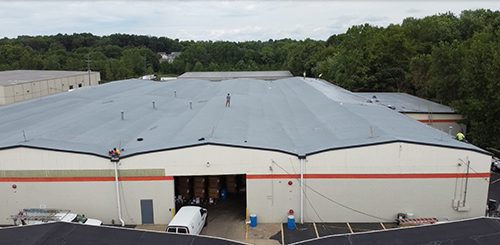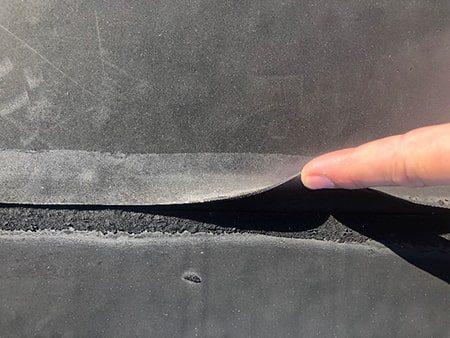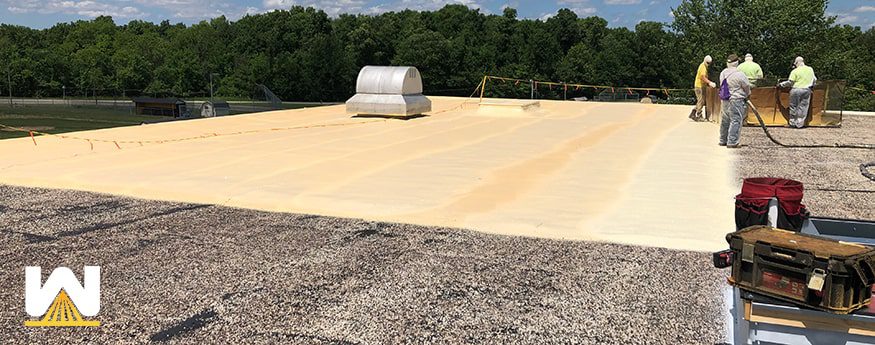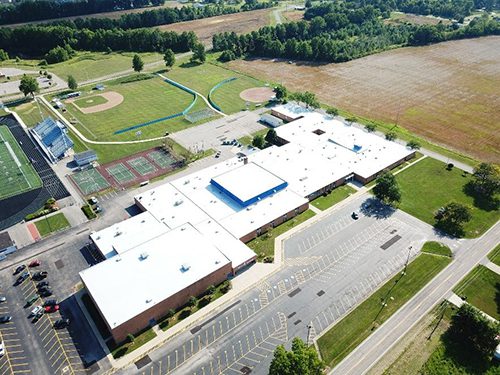So, you have a commercial roof and you’re thinking about doing a re-roof instead of a complete tear-off?
You’re trying to save some money by not removing the existing roof system.
Heck yeah!
But there are some “things” to know about re-roofing a commercial building before you think it’s in your best interest.
In this article, we cover:
- Can you legally re-roof a commercial roof?
- What re-roofing options do you have?
- What are the benefits of re-roofing vs a complete roof replacement?
- What are the cons of re-roofing vs complete replacement?
- How much does a re-roof cost?
I wanted to let you know that West Roofing Systems has been re-roofing commercial roofs since 1979. We specialize in two re-roofing systems: spray polyurethane foam and silicone roof coatings.
Now let’s get started with a quick definition of what re-roofing is.
What is re-roofing?
Re-roofing is the process of installing a new roofing system over an existing roofing system.
You might be thinking, “sounds awesome, I can install a new roofing system over my old one and not pay for the existing roof to be removed.”
Not so fast.
Some commercial roofs you cannot legally re-roof.
Photo: Silicone restoration over an existing EPDM roof
Can I legally re-roof my existing commercial roof?
Per building code, you can legally have a maximum of two roofing systems on a commercial roof.
If you already have two roofing systems, no matter how good of a condition it is, you will need to completely remove that system before installing another one.
But you don’t need to remove both roofing systems to install a new one.
If the second layer of your roofing system is dry and in good condition, this can remain. A roofing contractor could then re-roof over top to help with removal costs and stay within building code requirements, with two roofing systems.
NOTE: Something that most building owners don’t know is about silicone roof coating systems. Silicone roof coatings are considered “maintenance” and not another roofing system. Maybe this is a cost-effective option if you already have two roofing systems?
What re-roofing options are there for commercial buildings?
There are many options for re-roofing. It depends on what’s the best option for your roofing situation.
Sometimes it’s a matter of cost.
In this case, perhaps installing another single-ply roofing system over what you already have is a cost-effective option.
Sometimes it’s a matter of insulation value and long-term cost.
In this case, re-roofing your existing roof with a spray polyurethane foam roofing system can get you an R-value of 6.5 per inch of thickness and a roof that can be renewed over and over again.
Every situation is different depending on what kind of roofing system you currently have, the condition of your existing roof, and what your goals are.

Photo: Spray polyurethane foam roof over existing metal roof.
What are the benefits of re-roofing vs a complete roof replacement?
All the benefits of re-roofing versus a complete roof replacement revolve around minimizing the amount of tear-off.
NOTE: No roofing system should be installed over a roof that has wet, saturated, or moisture in the insulation. If these areas are not removed, they will cause problems in the future, or they will affect the performance of the newly installed roofing system.
Benefit #1 – Cost
Removing an entire roofing system is labor-intensive, which is costly. On some roofs, you might only need to remove 10% of the existing roofing system before installing a new system. On a complete roof replacement, you would have to pay for the labor to remove 100% of the existing roof.
Benefit #2 – Time
It takes longer to remove 100% of a roof than 10% of a roof. Time is money. You want the roofing contractor in and out so business operations can continue as normal.
Benefit #3 – Environment
Contributing roofing material to landfills isn’t good for the environment. It’s also costly to transport all those materials to the landfill.
In our example above, you can transport 10% of your existing roof to a landfill…or 100%.
What are the cons of re-roofing vs complete replacement?
One con is the eligibility with the number of roofing systems that are already installed.
West Roofing Systems has been around since 1979, and in that time, about 20-30% of roofs that we run into, already have two (or more) roofing systems installed.
Another con is if it’s beneficial to the building owner or not.
Some roofs that we’ve seen are in such poor condition that it wouldn’t be a great long-term solution to do a re-roof.
Some characteristics of a poorly conditioned roof are:
- More than 25-40% of the roof’s insulation has moisture, is wet, or is saturated.
- If the roof has seams, if the seams are losing adhesion, there is probably a large percentage of saturated insulation.
- If the roof hasn’t been maintained throughout its initial installation.
In some cases, a small tear in a roof is letting in water. If someone were maintaining that roof, they could identify the issue and fix the problem. But if the tear is ignored for years and years, a large amount of water has probably saturated a large portion of the roof’s insulation.

Photo: A seam that’s losing adhesion.
How much does a re-roof cost?
There are many, MANY variables when it comes to the price of re-roofing, including:
- How much of the roof’s insulation is saturated?
- What roofing system would you like installed?
- How many penetrations do you have?
- Is there an R-value that you require?
- Does the roof need additional taper due to a lot of standing water?
For example, for a flat, single-ply roof with a few penetrations, it might be cost-effective to re-roof it with another single-ply roofing system.
Another example could be a single-ply roof with hundreds of penetrations. Since a spray foam roof can be installed very quickly around penetrations, it might be cost-effective to re-roof it with spray foam.
Here are the ballpark prices for the most common commercial roofing systems available:
- Single-ply (EPDM or TPO) – $3.50 – $9.00 per square foot.
- Metal – $5 – $12 per square foot.
- Spray polyurethane foam – $4 – $7 per square foot.
- Silicone roof coating systems – $2 – $4 per square foot.
NOTE: The best advice we can give you is to contact a commercial roofing contractor and ask them what is the best solution for MY roof. Once they give you recommendations, ask them why, ask them about other solutions you’ve heard of. Pick their brain. Only then will you feel confident in choosing the best solution.
Want to learn more about re-roofing systems?
Two common re-roofing systems are spray foam and silicone roof coating systems.
Below are two “cheat sheets” which will give basic information about each system, such as:
- What problems does each system have?
- How are they installed?
- What advantages/disadvantages do they have over other roofing systems?
There are also some photos of finished roofs!




